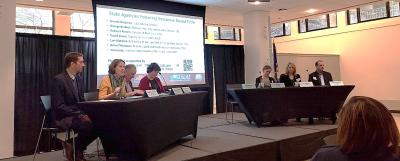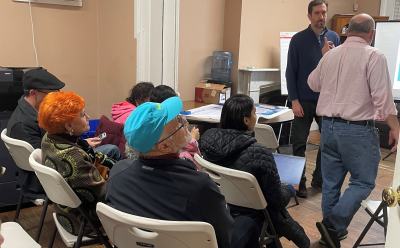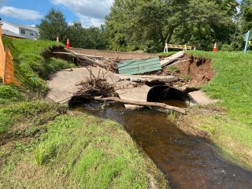What is the Resilience Roadmap?
Over the course of developing the Resilient Connecticut project, including the pilot project in the 1.0 area and the expansion through the 2.0 area, CIRCA and its partners documented lessons learned and recommendations for the future. These recommendations can provide a pathway forward for the state as we continue to experience the impacts of climate change. For a full discussion of lessons learned and detailed recommendations for the following overarching themes, please see the Resilience Roadmap Report.
1. Take action on existing vulnerabilities, zones of shared risk, and resilience opportunities.

The Resilient Connecticut planning process resulted in the identification of 177 Resilience Opportunity Areas (ROARs) across the 1.0 and 2.0 regions. These represent unmet needs for local and regional planning, project development and implementation support. The database of ROARs can be found on the Resilient Connecticut website.
2. Improve agency coordination and take advantage of existing programs and capacity.

Climate adaptation and resilience planning in Connecticut has evolved over the past decade. Today there are many different programs and partners that have built a solid foundation of knowledge, plans, data, and tools to support communities in planning for and adapting to climate change impacts. Going forward, existing programs and partners will need to better coordinate and work together to leverage this foundation for the benefit of communities across the state. This includes leveraging staff capacity and expertise across different state agencies to incentivize more collaboration.
3. Utilize equitable and inclusive planning approaches.

The entire community must be engaged in the assessment of adaptation needs, priorities, and projects. Broad participation is essential to ensure public support and to identify the needs of the most vulnerable. Communities that have been traditionally marginalized or disengaged from planning must be included from the start in setting priorities and developing solutions to climate resilience challenges. This requires resources to support participation and develop local capacity in EJ communities. The state should continue to build on the GC3’s efforts to remove barriers and move towards more equitable participation in the resilience planning process.
4. Prioritize emergency preparedness and recovery planning.

Prioritize preparedness for disruptive and extreme weather hazards by incorporating climate change into local and regional emergency planning and identify "Community Lifelines" that must function in the aftermath of a disaster. These are essential to human health and safety and sustain the operation of critical community services, government and business functions.
5. Build adaptation into infrastructure investments to avoid future costs.

To minimize future costs and social disruption, municipalities and state agencies should integrate climate change adaptation into all planning decisions and investments immediately. Every town's Plan of Conservation and Development and Hazard Mitigation Plan, for example, should enhance long-term resilience by including an assessment of climate change impacts into plans. Routine repairs and improvements that recognize future risk will yield a high return on investment.
6. Adapt existing and resist new development in coastal and riverine floodplains.

Higher mean sea levels will increase the frequency of flooding in areas that are currently flood prone. Enforcement and strengthening of existing policies will reduce risk to people, property, and municipal tax bases and make new commercial and residential development less vulnerable. Existing homes and businesses that were previously built in areas of flood risk will need to consider the full range of flood mitigation options including elevation, flood proofing, and voluntary acquisition of repetitive and severe repetitive loss properties, among others. New development should be avoided in areas where coastal flood risks are currently known as these areas will continue to flood more frequently by 2050. If municipalities, developers, and property owners choose to site new buildings and development in areas of known coastal and riverine flood risk going forward, future liabilities and costs should be fully assumed by property owners.
7. Develop a resilience project pipeline.

In many towns, there are several areas at-risk, and all need attention. Having a series of resilience projects underway will increase the likelihood of winning state and federal adaptation grants and increase support for the local share of matching costs. In addition, state agency resilience projects may need coordination with local projects. The creation of a central project pipeline database will allow for project planning and implementation between and across jurisdictions.
8. Establish and invest in new local funding sources.

Municipalities must begin to develop sustainable funding sources for longer term investments in resilience. A resilience project pipeline receiving federal and/or state support will require local cost-sharing, so a strategy for raising local funds is essential. In addition, many local projects may not qualify or receive significant federal funding. New policy tools in Connecticut have recently been created for this purpose. For example, Public Act 19-77 allows a municipality to create a resiliency reserve fund and PA 21-115, “An Act Concerning Climate Change Adaptation,” also provides municipalities with a suite of voluntary tools to fund climate resilience, including enabling of stormwater authorities and a new Environmental Infrastructure Fund within the Connecticut Green Bank.
9. Integrate emissions reductions and renewable energy deployment with adaptation and resilience planning.

Ultimately, the path forward to more sustainable communities includes large investments in reducing greenhouse gas emissions while also reducing risks and vulnerabilities to climate change impacts. It remains a critical goal to ensure these investments are coordinated to maximize our impact with limited resources. In many cases greenhouse gas reduction strategies can meet multiple objectives such as reducing heat risk to vulnerable residents, improving grid resilience, and improving the connectivity of multi-modal transportation.
10. Track changes in climate projections and policy options.

Since 2014, CIRCA’s research has provided Connecticut specific guidance on local projections of sea-level rise, precipitation, and temperature due to climate change. This research has been instrumental in helping the state establish planning guidance and policies. As climate science evolves, updated guidance based on the latest findings will be needed to continue informing Connecticut’s approach to adaptation and resilience. In addition, efforts to make climate science broadly accessible and understandable to the public will help to enable and inform action.